- Quick Read
- Deep Read ( 6 Min. )

Why is Christian Science in our name?
Our name is about honesty. The Monitor is owned by The Christian Science Church, and we’ve always been transparent about that.
The Church publishes the Monitor because it sees good journalism as vital to progress in the world. Since 1908, we’ve aimed “to injure no man, but to bless all mankind,” as our founder, Mary Baker Eddy, put it.
Here, you’ll find award-winning journalism not driven by commercial influences – a news organization that takes seriously its mission to uplift the world by seeking solutions and finding reasons for credible hope.
Explore values journalism About usIn Today’s Issue
- Under deadly Israeli siege, north Gaza residents face hard-line ultimatum
- Today’s news briefs
- Meet the ‘Haley Voters for Harris’ who could tip the election
- Beyond the gender gap: Presidential politics is a ‘masculinity contest’
- She fled war in Sudan. Now she grapples with returning.
- Civil rights on the red carpet: Freedom Awards honor 3 icons
- For descendants of Black Caribs, this heritage sail is about resilience
Monitor Daily Podcast
- Follow us:
- Apple Podcasts
- Spotify
- RSS Feed
- Download
TODAY’S INTRO
A new editor for the Monitor
 Mark Sappenfield
Mark Sappenfield
For many in the newsroom, Christa Case Bryant was one of those people you just knew would be editor someday. There’s the commitment to fairness that has been the Monitor’s hallmark for decades. There’s the reporting awards for covering Congress that show Monitor journalism at its best. And there’s the deep understanding and love for the Monitor’s mission and essential connection to Christian Science.
Well, as some of you now know, it has happened. With my family likely to remain in Germany for some time, I am stepping down, and I could not be happier to see Christa taking the position. Former Editor Willis Abbot said, “What newspaperman in the world wouldn’t be proud to be editor of The Christian Science Monitor!” It was an honor to do it for eight years.
Christa not only brings her credentials, but will also be the second woman to hold the post in our 116-year history. For a news organization founded by a woman, Mary Baker Eddy, that seems worthy of a cheer. You can read the official announcement here.
I’ve got much more I’m excited to do at the Monitor and will be taking a senior role, to be announced in January. Until then, I’ll continue to be your cruise director here and work to help Christa hit the ground running, with a transition planned for early next year. Please help me welcome her to the job.
Share this article
Link copied.

Help fund Monitor journalism for $11/ month
Already a subscriber? Login

Monitor journalism changes lives because we open that too-small box that most people think they live in. We believe news can and should expand a sense of identity and possibility beyond narrow conventional expectations.
Our work isn't possible without your support.
Under deadly Israeli siege, north Gaza residents face hard-line ultimatum
Where can one find safety in war? That has been an especially agonizing question for Palestinians in Gaza, ordered to and fro by Israel for more than a year. With death everywhere, one community after another has been reduced to rubble.

-
By Ghada Abdulfattah Special contributor
-
Taylor Luck Special correspondent
The Israeli army gave Lubna Nabil an ultimatum this week intended to terrify: Leave Jabalia, where she was born and has raised her children, or risk death.
It was a message first in Arabic leaflets dropped onto the refugee camp, and then barked through a quadcopter’s loudspeaker above the house where she and her five children were taking shelter with other families.
The army ordered them to leave as it intensified its offensive against Hamas forces in northern Gaza. But there were also concerns Israel was aiming to empty the entire region of its estimated 400,000 residents.
This is an area of conflict, she says the quadcopter warned. “Don’t think of north Gaza ever again.”
Leaving is a dangerous proposition, but pressures are mounting. A recent strike on a neighbor’s house wounded her son and daughter.
The siege has prevented relief organizations from bringing food or medicine into large swaths of northern Gaza. A Friday ground assault pushed the last functioning hospital in the area offline.
Ms. Nabil and others are weighing the risks of missile strikes and starvation against a potential outcome some say is as bad as death: being barred from returning home.
“I’m terrified that if I leave, I won’t be able to return,” she says.
Under deadly Israeli siege, north Gaza residents face hard-line ultimatum
The Israeli army gave Lubna Nabil an ultimatum this week intended to terrify: Leave or risk death.
It was a message first in Arabic leaflets dropped onto the Jabalia refugee camp, and then barked through a quadcopter’s loudspeaker over the house-turned-displacement center where she and her five children were taking shelter with other families.
The army ordered them to leave as it intensified its offensive against what it said are regrouping Hamas forces in northern Gaza.
This is an area of conflict, she says the quadcopter warned. “Don’t think of north Gaza ever again.”
But leaving Jabalia, where Ms. Nabil was born and raised her children, is a dangerous proposition.
She and many of the estimated 400,000 Palestinians under a three-week Israeli siege in northern Gaza are weighing the risks of missile strikes and starvation against a potential outcome some say is as bad as death: being barred from returning to their home and community.
“I’m terrified that if I leave, I won’t be able to return,” Ms. Nabil says from Al Hawaja Street, where she has been living with her children, ages 1 to 13, since their shelter was struck by an Israeli missile.
But pressures are mounting.
A recent strike on her neighbor’s house wounded Ms. Nabil’s son and daughter.
A Friday ground assault by Israeli forces on Kamal Adwan hospital rounded up patients and medical staff and pushed the last functioning hospital in northern Gaza offline.
“Mass-casualty incidents”
The siege, which entered its 24th day on Friday, has prevented the United Nations and aid organizations from bringing food or medicine into large swaths of northern Gaza and has halted a polio vaccination campaign in its tracks.
The U.N. and the World Health Organization warned that unless the vaccinations resume in the north, a polio outbreak would spread in Gaza.

The siege comes amid intensified bombings in what the U.N. is describing as “mass-casualty incidents,” killing dozens of civilians. According to Gaza’s health ministry, the Israeli siege has killed more than 600 people, including 87 people in a single strike last Saturday in Beit Lahia.
In three weeks, the siege has driven 60,000 people from the north Gaza regions of Jabalia, Beit Lahia, and Beit Hanoun, which border Israeli territory, pushing them further south into Gaza City, according to the U.N.
“They are doing everything to force us out of the camp,” Ms. Nabil says.
“We’ve been under fire, there’s not enough food, and the worst is the lack of water. They are pushing us to the brink, forcing us to move south.”
Yet after her brother was detained and disappeared by Israeli forces at a checkpoint as he evacuated south months ago, Ms. Nabil, like others, fears moving south.
Israel imposed the siege while battling a Hamas insurgency in northern Gaza that has not slowed despite the killing of Hamas’ top leadership, including the killing last week in southern Gaza of Yahya Sinwar. Fighters are planting explosives and launching rocket-propelled grenades at the invading Israeli army, killing a top commander on Sunday.
Yet senior diplomats, relief officials, and Palestinians worry that the Israeli campaign is imposing what has become known as the “generals’ plan” in northern Gaza. The plan, proposed by a retired general, advocated emptying the region of its population by mass forced displacement of civilians and a surrender-or-starve tactic to those who remain.
Some members of Israeli Prime Minister Benjamin Netanyahu’s governing coalition advocate clearing northern Gaza of Palestinians to create a military buffer zone, even establish Jewish settlements in the area.
In his meeting with the prime minister in Israel Tuesday, U.S. Secretary of State Antony Blinken reportedly pressed Mr. Netanyahu over the tactic and urged him to publicly disavow the alleged plans to starve and drive out northern Gaza’s population. He declined.
Strangled aid
From Oct. 1 to Oct. 22, the Israeli military approved only four out of 73 planned U.N.-led humanitarian missions from southern to northern Gaza, while 21 requests for humanitarian dispatches to Jabalia, Beit Hanoun, and Beit Lahia were denied, according to the U.N. Office for the Coordination of Humanitarian Affairs.
Since Oct. 1, Israel has only allowed the entry of fuel for hospitals and bakeries, the delivery of blood units to hospitals in Gaza City, and one delivery of fuel to north Gaza, the office said.
The Israeli Defense Ministry said Tuesday that 237 trucks containing humanitarian aid from Jordan and the international community had been transferred to northern Gaza over the previous eight days.
In his meeting with Mr. Netanyahu, Mr. Blinken “emphasized the need for Israel to take additional steps to increase and sustain the flow of humanitarian assistance into Gaza and ensure that assistance reaches civilians throughout Gaza,” the State Department said.
Yet as of Friday the siege continued, and aid and food were still not entering northern Gaza, aid officials say.

Despite the dangers, and calls by Israeli politicians and media figures to depopulate northern Gaza, Ms. Nabil and others have attempted to remain, fearing that should they leave, the area will be transformed into an Israeli military zone.
The thousands who remain in Jabalia and other communities north of Gaza City believe they are the first line of defense against a wider emptying of the whole Gaza Strip.
“I’m afraid that if we leave, it will be easy for them to evacuate everyone in Gaza,” Ms. Nabil says. “First [they will drive us] from the camp, then the central Gaza Strip, and eventually all of Gaza.”
Scenes of horror
Amid the Israeli strikes on Jabalia, Gaza health officials estimate that hundreds of men, women, and children, both dead and alive, are trapped under the rubble. The U.N. says Israel is preventing emergency teams from reaching Jabalia to aid in rescue efforts.
Gaza’s civil defense agency, which carries out search and rescue operations, said it was forced to pull out of northern Gaza due to threats from Israeli forces.
Bodies litter destroyed homes and streets. Voices crying out from beneath slabs of shattered concrete and steel are fading, and ending.
After another recent strike, Ms. Nabil and her family saw the bodies of a woman and a man lying against the fence of the house they were sheltering in.
Her eldest daughter, who is 13 years old, now regularly asks, “Will I be killed?”
But for even those who decide to leave northern Gaza, the journey is just as harrowing, Palestinians say.
Families driven from Jabalia and Beit Hanoun are being forced to move through an Israeli military checkpoint cutting off northern Gaza from Gaza City.
At the checkpoint, Palestinians say, men are being separated from women and children, who are forced to huddle in an earthen crater dug by the Israeli military.
Men are stripped, blindfolded, handcuffed, searched, and detained, with multiple families saying they lost contact with male relatives who have “disappeared” from the checkpoint.
On Wednesday, Ramy Zaanin says, he was anxiously waiting for his brother, Tareq, and his brother’s wife, Renal Hammouda, to arrive in Gaza City from Beit Lahia, where they were driven out by Israeli quadcopter fire.
Yet only Renal and their children made it.
“Where is Tareq?” Mr. Zaanin asked her.
“The quadcopter told them [the men] to leave through the checkpoint,” she said. Tareq never returned.
Mr. Zaanin recalls Renal lamenting about the family’s plight. “We have lost so much,” she told her brother-in-law. “Now, death feels easier than this endless cycle of moving and displacement.”
As of Friday, Ms. Nabil says she has decided to stay in Jabalia with her children.
“We are trapped in a nightmare that never ends,” she says.

Today’s news briefs
• Biden apology: President Joe Biden formally apologizes to Native Americans for the U.S. government’s role in the abuse and neglect of Native children sent to federal boarding schools to assimilate them into white society.
• Menendez brothers: Erik and Lyle Menendez still have a long road to freedom, even though the Los Angeles County district attorney has recommended their life-without-parole sentence be thrown out and the brothers be resentenced and immediately eligible for parole.
• Journalists killed in Lebanon: An Israeli strike kills three journalists in south Lebanon, and the United Nations refugee agency warns that Israeli airstrikes on a border crossing with Syria are hindering refugees trying to flee the war.
• Georgia goes to polls: The South Caucasus country of Georgia will go to the polls Saturday in a parliamentary election that many citizens believe may be the most crucial vote of their lifetimes.

Meet the ‘Haley Voters for Harris’ who could tip the election
Primary candidates and their supporters typically line up behind their party nominee. This year, Nikki Haley endorsed former President Donald Trump, but not all her supporters are on board. Their votes could sway a tight election.

- Quick Read
- Deep Read ( 6 Min. )
Across the United States, more than 4 million people voted for former South Carolina Gov. Nikki Haley in the Republican primaries. Now, in a neck and neck presidential race, Vice President Kamala Harris is making a play for those very voters, who could be the difference-maker in several swing states.
Instead of coalescing behind former President Donald Trump as the presumptive nominee, a notable share of Republican voters cast their primary ballots for Ms. Haley – even after she’d long suspended her campaign.
Mr. Trump appears unconcerned about winning that voting bloc and has not yet tapped Ms. Haley to appear on the campaign trail on his behalf. Meanwhile, the Harris campaign is zeroing in on Haley supporters.
Haley Voters for Harris, a super PAC unaffiliated with Ms. Haley, placed a seven-figure ad buy across swing states including Pennsylvania aimed at Haley supporters, who the group says are “independent-minded” voters.
“On the issues that are really most key to our voters, [Ms. Harris] has positioned herself as someone who will govern from the center,” says Craig Snyder, national and Pennsylvania director for Haley Voters for Harris.
Meet the ‘Haley Voters for Harris’ who could tip the election

Across the United States, more than 4 million people voted for former South Carolina Gov. Nikki Haley in the Republican primaries. Now, in a neck and neck presidential race, Vice President Kamala Harris is making a play for those very voters.
Instead of coalescing behind former President Donald Trump as the presumptive nominee, a notable share of Republican voters cast their primary ballots for Ms. Haley, even after she’d long suspended her campaign – in some states amounting to double-digit support.
Mr. Trump has appeared unconcerned about winning that voting bloc, which could be the difference-maker in several swing states. Last week on “Fox & Friends,” the former president dismissed a question about Haley supporters who remain reluctant to give him their support. “I beat Nikki Haley. I beat everyone else, too – badly,” Mr. Trump said. “Nikki is helping us already.”
Ms. Haley endorsed Mr. Trump in July and has said she would campaign for him if asked. “He’s aware that I’m ready if he ever needs me to do that,” she said last month on CBS’ “Face the Nation.” But she has yet to appear on the campaign trail for Mr. Trump, though there have been reports that his campaign is in talks to arrange an appearance with the former governor.
Polls show Mr. Trump is viewed unfavorably by a majority of Haley supporters, as is Ms. Harris – though she’s viewed more favorably than both Mr. Trump and President Joe Biden by these voters. An Oct. 9 survey found that 36% of voters around the country who supported Ms. Haley in the Republican primary say they’ll vote for Ms. Harris in the upcoming election. The poll by Blueprint, a Democratic research group, only included registered Republicans and independents. Among the Republican Haley supporters, 49% planned to vote for Mr. Trump, even though 64% of them said they had voted for him in 2020. Among independents, 38% said they would support Mr. Trump, down from 48% who’d backed him in 2020.
The Harris campaign, aided by anti-Trump Republican groups, is zeroing in on Haley supporters who may yet be undecided, in an election where the outcome could be determined by just tens of thousands of votes in a handful of states.
“Nikki Haley voters will show up to the polls,” but it’s a “toss-up” who they’ll vote for, says Dave Wilson, a South Carolina GOP strategist. “Donald Trump needs to bring every voter who might be on the fence across the fence, if he wants to win.”

“This election comes down to character”
Haley Voters for Harris, a super PAC unaffiliated with Ms. Haley, placed a seven-figure ad buy across swing states including Pennsylvania aimed directly at Haley supporters, who the group says are “independent-minded” voters.
“On the issues that are really most key to our voters, [Ms. Harris] has positioned herself as someone who will govern from the center,” says Craig Snyder, national and Pennsylvania director for Haley Voters for Harris.
The group is not just trying to get Haley supporters on board with Ms. Harris’ policies, says Craig Peterson, who oversees its Wisconsin efforts – though he says Ms. Harris’ policy positions come closer to those of President Ronald Reagan than do Mr. Trump’s. Rather, the goal is to assure Haley supporters that they can vote for Ms. Harris without forfeiting their identities as Republicans.
Mr. Peterson says there are 110,000 “double haters” – people who voted for Ms. Haley or former New Jersey Gov. Chris Christie and don’t like either of the two nominees – in Wisconsin. His group’s approach in that state, where the race could be as close as 20,000 votes, is “laser-guided,” he says, with TV ads aimed directly at those voters, many of whom are suburban women.
Matthew McCaffery, a lifelong Republican from Pennsylvania, supported Ms. Haley in the primary. Back in 2016, wanting a change in the political status quo, he’d backed Mr. Trump. But soon after, Mr. McCaffery began feeling as though the man he’d voted for couldn’t do the job.
By the time Gen. James Mattis called Mr. Trump unfit to serve, Mr. McCaffery – a Marine Corps veteran who had served in Iraq under Mr. Mattis – had decided to vote for Mr. Biden in 2020.
This year, he’s voting for Ms. Harris.
“This election comes down to character, behavior, and just who can be a steady hand at the wheel,” says Mr. McCaffery. “Though I may not agree with a lot of what the vice president believes in, I know that she’ll be a capable leader.”
In Pennsylvania, 16% of Republicans voted for Ms. Haley in the primary, even though she’d dropped out of the race seven weeks earlier. Ms. Harris and Mr. Trump are now in a tight race in the state, and Democrats believe many of the 160,000 or so Haley supporters may be persuadable.
“Given that Pennsylvania is likely to be one of the more pivotal states and given that it could be close, anything could end up making a difference,” says Anthony Fowler, a professor at the University of Chicago. “I think it does make sense to go for people in the middle.”
A flurry of events with anti-Trump Republicans
Ms. Harris has been campaigning with former GOP Rep. Liz Cheney and other anti-Trump Republicans, holding a series of events in battleground states designed to appeal to disillusioned Republican voters.

“The coalition we have built has room for everyone who is ready to turn the page on the chaos and instability of Donald Trump. And I pledge to you to be a president for all Americans,” Ms. Harris said at an event in Pennsylvania last week, where she stood in front of a white barn decorated with a “Country Over Party” sign, on the banks of the Delaware River near where George Washington crossed on Christmas night in 1776.
Former Republican officials including U.S. Reps. Jim Greenwood and Adam Kinzinger, and Trump administration official Olivia Troye also spoke to the invite-only crowd of about 500. Others, including former Rep. Barbara Comstock, joined on the dais. After, Ms. Harris sat for an interview with Fox News’ Bret Baier.
Ms. Harris has won other recent endorsements from Republicans, including in a letter signed by 20 GOP leaders and voters from Wisconsin, from former Haley campaign staff in Michigan, and from former Arizona Sen. Jeff Flake. Ms. Cheney’s father, former Vice President Dick Cheney, has also endorsed the Democratic nominee.
The event in pivotal Bucks County, Pennsylvania, shows that the Harris campaign is serious about welcoming GOP voters uneasy with Mr. Trump, says Mr. Greenwood, a six-term former member of Congress from the area.
“[It signals] that they’re seeking Republican support, and that they have Republican support, and that they want more Republican support,” says Mr. Greenwood, a co-chair of Republicans for Harris.
Mr. McCaffery, the former Marine, says he knows other Republican voters who plan to break with their party this election. Many just aren’t publicizing it, he says. “They’re definitely more quiet,” an approach he recommends after experiencing a swatting call, receiving hostile mail and online comments, and being ousted from his position as a local GOP leader since speaking publicly about his disapproval of Mr. Trump.
Pro-Harris Republican groups bet that if the Harris campaign can sway even a third of undecided Haley supporters in key swing states, that could bring Ms. Harris a winning margin.
But for some, dislike of both candidates is so strong they can’t see themselves voting for either one. Speaking by phone as she delivered ballots to a Philadelphia-area nursing home, Kim Decker, a Harris campaign “super volunteer,” says she often meets undecided voters as she canvasses near her home north of the city. Many of them may wind up filling out the rest of the ballot but not casting a vote for president, she says. “They’re completely decided that they’re not voting for Trump or for Kamala.”
There’s an answer for those Republicans who feel torn between their Republican values and their dislike of Mr. Trump, says Mr. Greenwood, the former congressman. “There will be lots of Republicans in Congress,” he says. “It’s not like there’s going to be some left-wing agenda moving through Congress.”

Beyond the gender gap: Presidential politics is a ‘masculinity contest’
The gender gap in U.S. presidential politics is not new. But in this election year, the importance of projecting power has become gendered. Both candidates are wooing voters with their own brands of masculinity.

- Quick Read
- Deep Read ( 5 Min. )
In the United States, women have, for decades, tilted toward Democrats, who today are leaning into issues like abortion access and economic equality. Men have leaned toward Republicans, who are evoking traditional gender roles in discussing gun violence, child care, and family planning.
But this campaign underscores a preference – beyond gender – for masculinity in the nation’s highest office, says Lindsey Meeks, a University of Oklahoma professor specializing in political communication and gender: “It doesn’t have to necessarily be a man, but [voters are] still really liking a masculine presence at that level.”
Former President Donald Trump’s campaign displayed hypermasculine images. From appearances with pro wrestlers to frequent use of aggressive language, he has connected with male voters who value a certain type of masculinity.
Vice President Kamala Harris walks a finer line, attempting to appeal to men while keeping her base among women. She’s played up her more masculine qualities – as California’s “top cop” and as a gun owner.
“Almost every election is, in fact, a masculinity contest,” says Dan Cassino, executive director of polling at Fairleigh Dickinson University. “To be taken seriously as a potential leader, you have to show masculine traits.”
Beyond the gender gap: Presidential politics is a ‘masculinity contest’

As early voting gets underway across the United States, one political divide has become clear: Most men prefer former President Donald Trump. Most women prefer Vice President Kamala Harris.
That gap reflects party narratives throughout this election season – with Democrats leaning into issues like abortion access and economic equality, while Republicans have evoked traditional gender roles in discussing gun violence, child care, and family planning.
This gender gap, while significant, goes back decades. What this campaign underscores is Americans’ broader preference – beyond gender – for masculinity in the nation’s highest office.
The president “doesn’t have to necessarily be a man, but [voters are] still really liking a masculine presence at that level,” says Lindsey Meeks, a University of Oklahoma professor specializing in political communication and gender.
Power projection
Trump stumper Tucker Carlson at a rally this week implicitly referred to his presidential candidate as “Dad.” He unfurled a metaphor in which “when Dad comes home” he deals with his misbehaving children – implicitly the Democrats: “You’ve been a bad little girl, and you’re getting a vigorous spanking.” It capped a campaign laden with hypermasculine images. From appearances with pro wrestlers to frequent use of aggressive language – including a recent vulgar reference to the late golf legend Arnold Palmer’s anatomy – former President Trump has consistently connected with male voters who value a certain type of crude masculine power figure. And Friday he is set to record an interview with Joe Rogan, the podcaster wildly popular with young male audiences, including young Black men.

Ms. Harris is walking a finer line, attempting to appeal to men while keeping her base among women. Her choice of Tim Walz as a running mate brought some balance to her femininity. But she’s also played up her more masculine qualities – as California’s “top cop” and as a gun owner. And, this week, former President Barack Obama rallied supporters on her behalf in Detroit alongside rapper Eminem, making a pointed appeal to young men to support the Democratic candidate.
Projecting strength is trickier for women, says Dan Cassino, who conducts polling for Fairleigh Dickinson University. “Female candidates have to be masculine, but not too masculine, and feminine, but not too feminine. Whereas masculine male candidates just have to be masculine.”
Recent polling he has conducted illustrates those differences: Among registered voters, 41% say Mr. Trump is “completely masculine.” Of that share, 84% say they’re going to vote for him. Some 54% say Ms. Harris expresses some degree of masculinity.
“Almost every election is, in fact, a masculinity contest. We just don’t see it because it’s [been] just two men,” he says. “To be taken seriously as a potential leader, you have to show masculine traits.”

Bold lines along the gender divide
The division along gender lines is stark: In a Pew Research Center survey this month, 51% of men and 43% of women lean toward supporting Mr. Trump. Ms. Harris has the mirror image of that support – 52% of women and 43% of men prefer her candidacy.
Another Pew survey shows some voters believe those candidates’ policies would benefit their corresponding gender – and harm the other. Among registered voters, nearly half say a Harris presidency would help women, while 36% believe it would make things worse for men; 45% say a Trump win would make things better for men, and 46% say it would be worse for women.
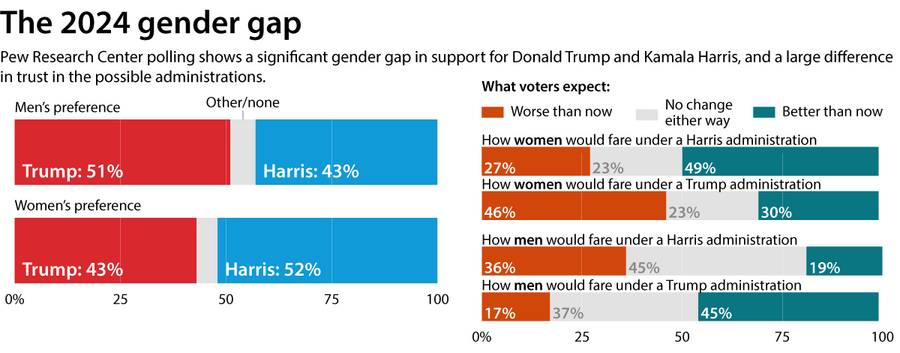
Pew Research Center
This polarity reflects ways in which the two political parties have solicited support for their respective platforms: Republicans have doubled down on gender stereotypes, while Democrats, until recently, have centered their messaging on issues important to women and racial minorities.
Lost in this political gambit, say some experts, are the real needs of contemporary men and boys.
“The main sound on issues of boys and men from the Democrats until very, very recently in the race has been the sound of silence,” says Richard Reeves, founder and president of the American Institute of Boys and Men. “Whereas on the Republican side, there’s been a lot of talk and a lot of performance.”
Both parties are treating gender issues as a zero-sum game, says Mr. Reeves, adding, “I don’t think it’s good in the long run to have a men’s party and a women’s party. I think we do have to rise together.”

A large draw for women to the Harris ticket has been the Democratic position on abortion access and other fertility-related options, says Dr. Meeks. Men tend to be more hawkish than women on defense and international relations – and they’re more likely to be threatened by a Harris-Walz ticket that inverts historical gender norms. She adds, “You could see any of those levers pushing [men] towards Trump over Harris.”
Changes for men, and the politics of empowerment
That’s not to say all men – or women who depend on male success for their economic security – don’t support women’s issues. But the rise of women’s earnings and subsequent choices in recent years has made men less of an economic necessity for women, say experts.
“That is an amazing economic liberation and exactly what the women’s movement was about in that way,” says Mr. Reeves. But this liberation for women has presented a difficult transition for men, who face their own issues, including higher suicide rates and lower high school graduation rates than women, and other pressures related to working and making money.
Republicans have tailored their messaging to acknowledge men in ways that Democrats have not, says Mr. Reeves. “The basic underlying [Republican] message is ‘We are guys. We like guys. And we like the things that guys like.’ And so that’s a strong cultural message from the right.”
But the contrasting messages around gender may have eroded the party’s stronghold among Black men, while another reliably Democratic bloc – Hispanic voters – is also shifting toward Mr. Trump. With the presidential race in a statistical dead heat, every vote matters. And the Harris camp is working to broaden its appeal – ramping up its pitch to men while continuing to double down on issues that appeal to its current base, like abortion and equality.
“The Harris campaign is trying to talk to men around issues of the economy, talking about small businesses, talking about the kind of an economy of opportunity,” says Debbie Walsh, director of the Center for American Women in Politics at Rutgers University. “But they’re also very much hoarding that women’s vote. I think there’s no question that they’ve read the memo that women voters really matter.”
Indeed, more women than men tend to vote. In the 2020 election, it was 10 million more.
At the same time, says Mr. Reeves, “Republicans are doubling down on their identity as the men’s party, and [Republicans and Democrats] are just hoping to turn out enough on their side to counteract the loss.”

Pew Research Center

She fled war in Sudan. Now she grapples with returning.
Sudan’s civil war has forced more than 11 million people to flee their homes, one of the worst displacement crises on Earth. The journey of one such family, the Natheers, shines light onto what that situation is like for the people living through it.

- Quick Read
- Deep Read ( 6 Min. )
-
By Hipa Abdalazeem Special contributor
-
Ryan Lenora Brown Africa editor
Since civil war broke out between two rival factions of Sudan’s military in April 2023, the conflict has forced more than 11 million people to flee their homes. As the crisis deepened this summer, the Monitor followed a Sudanese family, the Natheers, as they fled their home in Khartoum, the capital, and paid a smuggler to take them across the border to Egypt.
“We left like thieves so no one would notice us,” says Ru’a al-Natheer, recalling the day last November that rebel soldiers stormed her family’s home, threatening to execute everyone. The family – including Dr. Natheer, her five siblings, and their parents – left the same morning, not even taking the time to lock the doors behind them.
They boarded a bus heading north, toward Sudan’s border with Egypt. During the ride, Dr. Natheer began contacting smugglers on Facebook. By the time the family arrived, a driver was waiting. They knew the conditions of the crossing were treacherous, with no roads and extreme desert temperatures. They tried not to think of the stories they’d heard about migrants being abandoned and dying of thirst.
Instead, they handed over $2,600 – half their life savings – and climbed inside the truck.
She fled war in Sudan. Now she grapples with returning.
This is the third of four articles from Sudan that we are publishing this week, highlighting that country’s travails and citizens’ efforts to overcome them. Read the first two articles here and here.
Ru’a al-Natheer lay beneath a pile of carpets and blankets on the floor of her family’s chicken coop and listened as the footsteps approached.
She knew what the soldiers would do if they found her and her sisters.
“You have beautiful daughters,” they had told her father, the implication dangling unspoken in the hot Khartoum air.
For six months, Dr. Natheer and her three sisters had been hiding in the coop whenever the men came to the house, but it never got easier. As the footsteps came closer, the young women shivered violently, as though it were 30 degrees Fahrenheit outside instead of 100 F.
Then the footsteps suddenly began to retreat. The sisters listened with a mixture of relief and horror as the soldiers, members of a Sudanese paramilitary group known as the Rapid Support Forces, moved through the rest of their house, smashing windows and destroying furniture.
When the men were finally gone, the women emerged to find their father collapsed on the floor, sobbing. The soldiers had left him with a warning: If he didn’t turn his daughters over by the next day, they would execute the entire family.
Their mother told them to pack quickly. They were leaving that morning.
Since civil war broke out between two rival factions of Sudan’s military in April 2023, the conflict has forced more than 11 million people to flee their homes. To date, as many people have been uprooted by Sudan’s war as by Ukraine’s against Russia, in half the time.
As the crisis deepened this summer, the Monitor spoke with several Sudanese and those who had smuggled them along one popular escape route – across the country’s northern border to Egypt – to understand what one of the world’s worst displacement crises looks like for those living through it.
A quiet life
For Dr. Natheer, Sudan’s civil war sliced suddenly through a life of quiet ambition. A veterinarian in her early 20s, she lived with her parents and five siblings in a tidy suburb of Khartoum, Sudan’s capital. She had recently landed a job as a researcher at the Ministry of Animal Resources, and her salary helped support her younger siblings’ education.
“I was extremely happy about that,” she recalls.
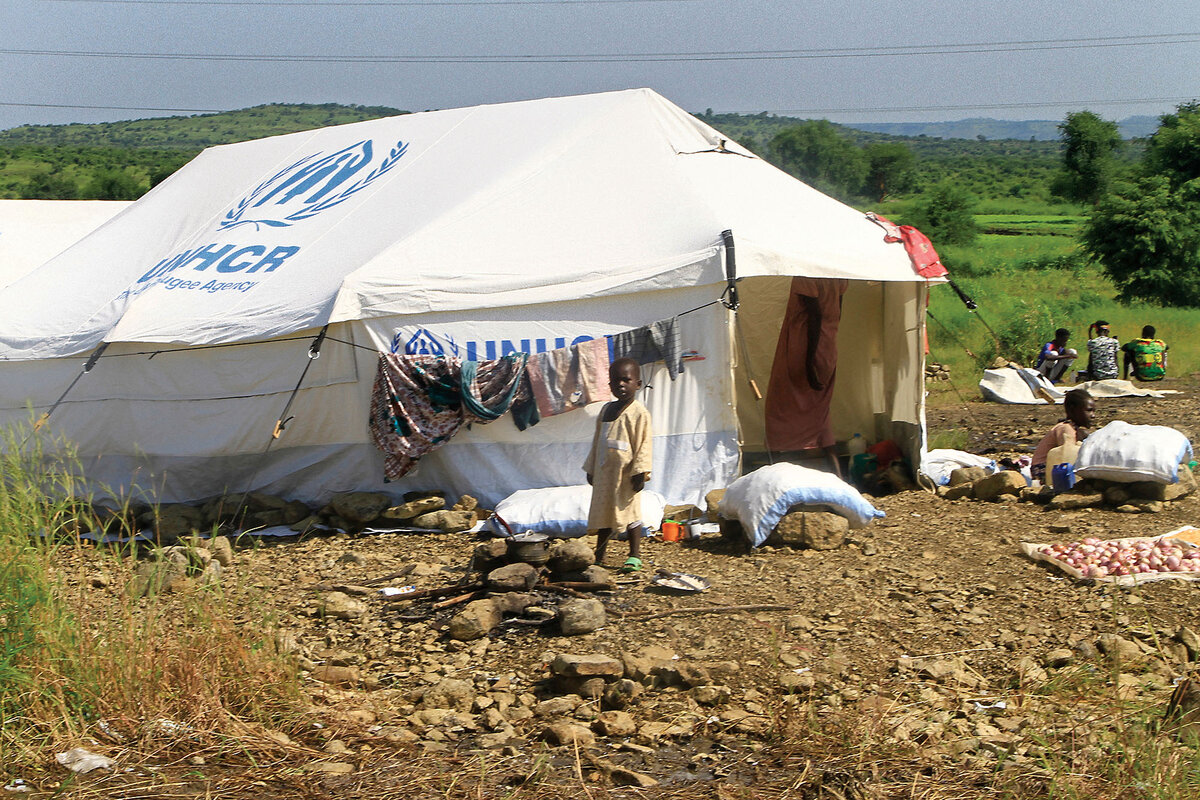
Everything changed when fighting tore through the capital in April 2023, after a power struggle between Sudan’s two top generals exploded into open warfare. Suddenly, the neighborhood was filled with gunfire and explosions. Paramilitary fighters regularly stormed their house looking for “girls and gold,” Dr. Natheer remembers.
On that frantic November morning when the soldiers issued their ultimatum, the family members fled so quickly they didn’t even stop to lock the doors behind them. “We left like thieves so no one would notice us,” says Dr. Natheer.
The family boarded a bus headed north with no real plan. But as they crawled along crowded roads, one military checkpoint after another, Dr. Natheer began searching Facebook for smugglers who could take the family across the border to Egypt.
By the time they arrived in the northern town of Sidon eight hours later, a driver was waiting.
The Natheers handed over $2,600 – about half their life savings – and climbed into the back seat of his truck.
“Unofficial” crossings
Until recently, Sudan and Egypt had an agreement that allowed their citizens to cross freely over their shared border, able to live, work, and own property on both sides. But shortly after the war began, in June 2023, Egypt abruptly suspended the policy, citing security concerns.
As a result, nearly “all opportunities for legitimate entry for Sudanese have been closed,” explains Amira Ahmed, a scholar of migration at the American University in Cairo and an activist for refugees. Instead, she says, people were increasingly forced to turn to what she calls “unofficial means of entry.”
The Facebook page Dr. Natheer found is one of many that organize these “unofficial” crossings, ferrying migrants to the border in large, open-back trucks called “Fly Boxes,” a euphemistic reference to an airline popular in the region, Flydubai.
On his page, “Sudanese Refugees Platform in Egypt,” smuggler Abdel Rahman Farouk arranges for his customers to be picked up at various points in Sudan and driven to the border. Then Egyptian smugglers take them to the city of Aswan.

In total, the trip from the border to Aswan should take 12 hours. But the smugglers cannot use official border crossings or roads, and vehicles frequently break down in the desert.
Sudanese who took the same route with other smugglers say they were subjected to barbaric conditions on the journey. They describe being given water to drink from dirty fuel cans and having to wear diapers because their drivers would not stop to let them relieve themselves.
At night, “We were terrified by the howling of the wolves,” recalls Salah Ibray, a car mechanic from Khartoum who made the journey last November.
For many smugglers, the work is morally complex. “These are my fellow countrymen,” says Mohamed al-Rashidi, a smuggler who also regularly rescues migrants stranded in the desert, according to several local sources. He wants to help people survive the war, he says, not to extort them.
On one recent trip, he recounts, as the desert temperature climbed to 122 F, he arrived at a marooned Fly Box to find a group of migrants suffering badly from the heat.
He did what he could, he says. He took the living to the nearest hospital, and paid their bill. Then he buried the dead.
For his part, Mr. Farouk says he always organizes a convoy of five or six cars to avoid leaving passengers stranded because of mechanical issues.
But in June, he had an experience that upended his life forever. During a heat wave, he says, he was driving for another smuggler when the convoy ran out of water. A 12-year-old boy with a health issue in his truck died first, and then his 9- and 6-year-old brothers.
“The wailing of their mother and sister has not left me, and it never will,” Mr. Farouk says.
Finding home
Six hours into the Natheers’ drive, their car broke down in a desolate, mountainous area on the Sudanese side of the border.
The driver announced he was going for help. But as the hours ticked past in the frigid desert night, they realized he was never coming back. By the time another passing car took pity and picked them up four days later, Dr. Natheer says, they were “on the brink of death.”
When the family at last reached Cairo, things seemed better, at first. They rented an apartment and registered as refugees with the United Nations.
But Dr. Natheer says Egyptians harassed them “constantly,” hurling racist remarks and telling them to go back to their own country. They struggled to find work, and their savings dwindled.
After six months, the family began considering the unthinkable: returning to Sudan.
When the Sudanese military retook Omdurman, a city just west of Khartoum, in mid-April, the Natheers decided this was their chance. Dr. Natheer, her father, and her two brothers went home, promising to send money to those who remained in Cairo.
In Omdurman, they moved into a family house abandoned at the beginning of the war. They swept the glass from the floor, and started raising chickens in the backyard coop. Dr. Natheer’s father found a job as a bus driver.
It was a shadow of their former life.
But at least, they told themselves, they were finally home.
Staff writer Ryan Lenora Brown contributed to this report from Montreal. This article was published in collaboration with Egab.
Part 1: A journalist recounts his daughter’s miraculous birth in war-torn Sudan
Part 2: ‘They are our people’: How community kitchens are piecing Sudan back together

Civil rights on the red carpet: Freedom Awards honor 3 icons
The Freedom Award is the National Civil Rights Museum’s signature fundraiser. A closer look at its recipients shows the relics and relevance of an age-old dream.
- Quick Read
- Deep Read ( 7 Min. )
On the red carpet near the Orpheum Theatre, one of the stars of “Rush Hour” is escorting civil rights advocate Xernona Clayton. Chris Tucker, a native son of Atlanta, never strays too far away from his comedic roots. As a DJ plays Michael Jackson’s “Don’t Stop ’til You Get Enough,” Mr. Tucker, a friend of the late pop star, goes into one of the King of Pop’s trademark shimmies.
When asked about another Atlanta civil rights icon, John Lewis, Mr. Tucker grew serious. “Becoming his friend and having him as a mentor, it’s a blessing,” Mr. Tucker says. “He lived a whole life of service. He was a great example for my generation and the generation after me.”
Mrs. Clayton, filmmaker Spike Lee, and attorney Sherrilyn Ifill were honored with the prestigious Freedom Award by the National Civil Rights Museum.
After she received her award, Mrs. Clayton reflected on a life of defiance and determination, a story that stemmed from a white butcher pulling a knife on her and her twin sister and their boyfriends at a restaurant.
“To this day, that look of a knife and a white man telling you, ‘You don’t belong here,’ still bothers me,” she said.
Civil rights on the red carpet: Freedom Awards honor 3 icons

The FedExForum usually houses the NBA’s Memphis Grizzlies. On this particular day, the keepers of a dream held court. Yes, that dream – the one conjured up by Martin Luther King Jr.
Three of those keepers – civil rights advocate Xernona Clayton, attorney Sherrilyn Ifill, and filmmaker Spike Lee – were on hand to shape the next generation of change-makers. The Freedom Award Student Forum gave high school students the chance to speak with the iconic trio only hours before they are presented with the prestigious Freedom Award by the National Civil Rights Museum.
That evening, on the red carpet near the Orpheum Theatre, one of the stars of “Rush Hour” is escorting the iconic Mrs. Clayton. Chris Tucker, a native son of Atlanta, never strays too far away from his comedic roots. As a DJ plays Michael Jackson’s “Don’t Stop ’til You Get Enough,” Mr. Tucker, a friend and proud mimic of the late pop star, goes into one of the King of Pop’s trademark shimmies.
When asked about another Atlanta civil rights icon, the late Congressman John Lewis, Mr. Tucker grew serious. “That’s another [legend]. ... Becoming his friend and having him as a mentor, it’s a blessing,” Mr. Tucker says. “He lived a whole life of service. He was a great example for my generation and the generation after me.”
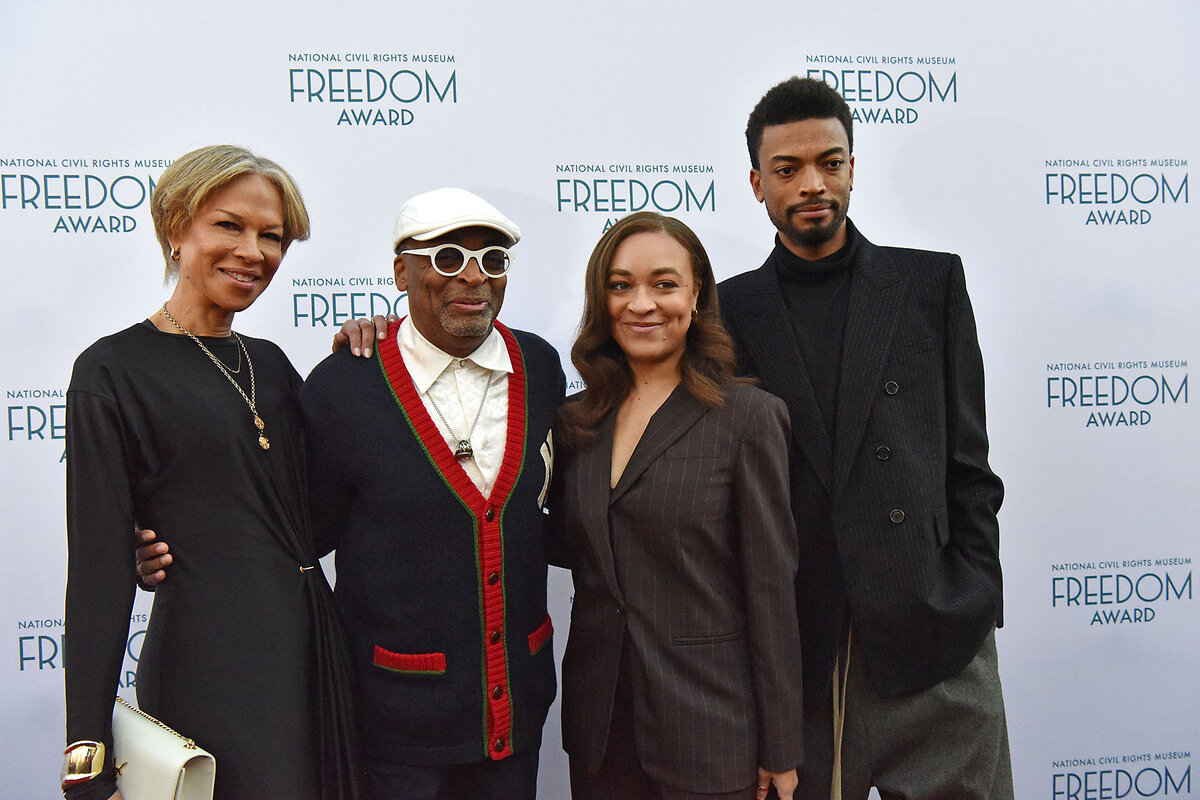
Less than a mile from the Orpheum is the National Civil Rights Museum, which is housed at the Lorraine Motel, the site of Dr. King’s assassination. A few steps before the glass door entrance at the museum, there is a wreath and a harrowing marker, which includes these lines from the book of Genesis:
They said one to another,
Behold, here cometh the dreamer …
Let us slay him …
And we shall see what will become of his dreams
It’s impossible to separate Dr. King, the museum, and these awards. They’re all part of perhaps the most recognizable movement in this country’s history.
Mrs. Clayton’s presence is reflective of this movement and how it’s changed over time. A native of Muskogee, Oklahoma, the 94-year-old moved from Chicago to Atlanta in 1965 and joined the Southern Christian Leadership Conference. She worked closely with both Kings – Martin and Coretta Scott – in the midst of her own broadcasting career, which began in 1967. Mrs. Clayton was the first Black person in the South to have her own TV show. While she worked for 30 years with Turner Broadcasting System and became an executive in 1988, she never forgot her community. She created the Trumpet Awards in 1993 to honor Black achievements.
How a knife launched a mission
After she received her Freedom Award, Mrs. Clayton reflected on a life of defiance and determination, a story that stemmed from a white butcher pulling a knife on her and her twin sister and their boyfriends at a restaurant many years ago.
“To this day, that look of a knife and a white man telling you, ‘You don’t belong here,’ still bothers me after all these years I’ve been living,” she said in her speech. “And while I could sit around and brood about it, I decided I’m gonna do something about this to relieve myself of this pain. And I started then, and it continues today every time I see or hear, feel, or determine that there’s a move somewhere in my society that prevents me from being a full and qualified citizen.”
She also talked about fighting dragons, a commentary reflective of her influence on the late Calvin Craig, the former Grand Dragon of the Ku Klux Klan. Mr. Craig famously denounced the klan the same month Dr. King was assassinated, and credited Mrs. Clayton’s influence.
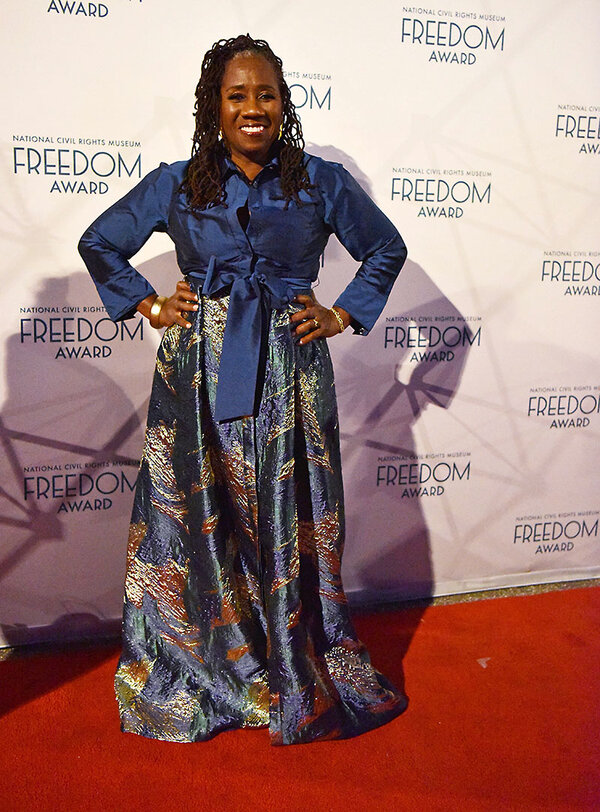
“I have adopted that philosophy that if you can, you will. If you want to, you will. I’ll continue to do that as long as I live, to rid society from the dragons of prejudice,” she said. “And I had an excellent partner in Martin Luther King Jr., whom I brought to Memphis that awful year that we wish we could forget. ... He was doing what we both knew we had to do, that when you find pockets of prejudice, you keep on fighting, don’t give up. The victory will be yours in the end.”
Mr. Lee has made an entire career of narrative building – and rebuilding. Still, there’s one dark date in American history that speaks for itself – April 4, 1968. Mr. Lee, who was 11, remembers it like it was yesterday.
“I was sitting on my stoop. ... I heard a woman screaming and then she walked towards our house. It was my mother screaming,” he recalled. “And I’d never seen my mother that hysterical. ‘They killed him. They killed him. They killed Dr. King.’”
Like Dr. King, Mr. Lee was a Morehouse man born in Atlanta. The filmmaker’s career has notably dealt with race relations and events specific to the Civil Rights Movement. As relates to Dr. King, Mr. Lee’s portrayal of “Malcolm X” in 1992 might seem more ironic, but no less relevant. Mr. Lee also directed and produced a documentary about the 16th Street Baptist Church bombing, “4 Little Girls.”
One of Mr. Lee’s quotes about America and its treatment of Black people rang out before he was presented with the Freedom Award: “This United States of America [was] never set up for us to succeed. It was not meant for us to thrive. Now yes, things have changed, more opportunities, but the barricades are still there. And so, once you know the plan, the game, you can move accordingly.”
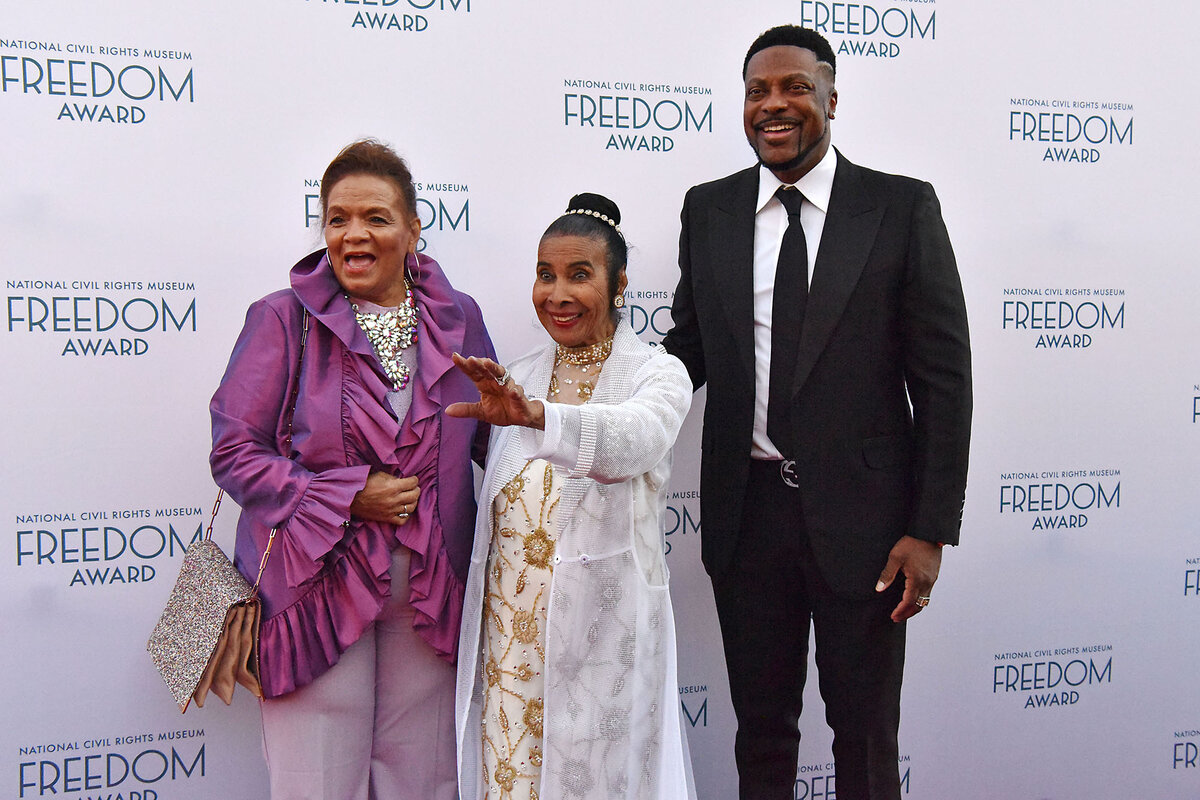
“We are called on ... to make a new American democracy”
Back in 2016, Sherrilyn Ifill wrote a powerful eulogy about her cousin, Gwen, a media icon who died that November.
“My cousin, Gwen, and I were the daughters of two immigrant brothers, who were driven by their faith in God, their love for family, for black people, and by their ambition and determination,” she wrote for The American Prospect. “They also believed deeply in the idea of America – even with all its flaws, and they made us, their many children, believe in it too.”
After she received the Freedom Award, Ms. Ifill spoke about democracy in a spirit that Dr. King described as “the fierce urgency of now.” What resulted was a soul-stirring challenge to not only attendees, but the country itself.
“I’m not trying to restore American democracy. I’m not trying to bring it back like it was. I loved Barack Obama too, but I’m not trying to be back like it was when he was president,” she said. “What we are called on to do is to make a new American democracy, and to do this, we need power.”
“Just as those who came before us, it’s now time for us to walk in our rightful position as founding mothers and fathers of the new American democracy. ... We are being called upon in this moment to do so,” she said. “I’m not sad because it is only when the old shows itself to be no longer tenable for the majority that people’s ears and eyes are open to true transformation. This is our moment.
“We’re being called upon to bring our radical democratic imagination to push this country into a new, more dynamic place of democracy,” she continued.
Ms. Ifill’s optimism, tinged with a no-nonsense approach to oppression, is what makes her the Legal Defense Fund’s forever lawyer, currently serving as president and director-counsel emeritus. She encouraged those in attendance to “overlay our power with love.”
“There’s strength in love. We must have power and we must have love,” she said. “Dr. King said it clearly. He said, power without love is reckless and abusive. Love without power, he said, is sentimental and anemic.”
If the morning’s student forum was any indication, the heroes of tomorrow are already meeting the moment. Three of the recipients’ young counterparts continued their proud social justice legacy.
Where Mr. Lee famously threw a trash can through the window in “Do the Right Thing,” Corey Irby, a senior at East T-STEM Academy High School, did the opposite. Mr. Irby planned and led a nationally awarded cleanup effort. Ms. Ifill, with the NAACP’s Legal Defense Fund, was not the only attorney celebrated this day. Maria Machado, a student attorney and senior at Central High School, co-founded Soy Mia, a nonprofit providing free menstrual products across Memphis, focusing on the Hispanic community.
Like Mrs. Clayton, the third honoree, Adaria Crutcher, worked tirelessly toward the preservation of Dr. King’s dream. But Adaria’s sense of loss mirrored that of Bernice King – the death of her father.
“When my dad passed away in 2021, it was super hard for me to cope,” says Ms. Crutcher, a senior at White Station High School. “I realized that lots of kids just throughout my community, they don’t know how to properly react to their emotions. They either just suffocate them, or they try to ignore them, but that’s never a good thing.”
She turned tragedy into triumph with two of her classmates as they created a “safe environment” for students who experience suicidal thoughts. The name of their project? Storyunfinished.

In Pictures
For descendants of Black Caribs, this heritage sail is about resilience
For the Garifuna, a journey to the island to which their descendants were exiled is as much about standing strong today as it is about remembering the past.

- Quick Read
- Deep Read ( 3 Min. )
-
By Seth Berry Contributor
Every March, Garifuna people make a pilgrimage from mainland St. Vincent to nearby Baliceaux island. The Garifuna’s ancestors were Black Caribs who were exiled to Baliceaux in 1796 after years of war with the British on St. Vincent.
This year, a group of descendants making the hourlong trip by catamaran sits solemnly as the choppy sea crashes against the hull. Their eyes are focused on the coastline of Baliceaux. When the boat reaches the shore, the passengers – from countries including Honduras, Belize, and Guatemala – jump onto the beach and encircle a large bowl of burning incense. They intertwine fingers and begin a ritual song to bless the land.
“It’s the moment my feet touch the water, then the beach. I feel at home. I feel enveloped by my ancestors,” Queen Mother Freda Sideroff says. She is originally from Belize, but the Republic of Cameroon awarded her the title “queen mother” based on her ancestral connections. She now lives in the United States.
Expand the story to see the full photo essay.
For descendants of Black Caribs, this heritage sail is about resilience
In 1796, after years of war with the British on St. Vincent, about 5,000 Black Caribs, whose descendants are now known as the Garifuna, were exiled to nearby Baliceaux island. Almost half of them died there because of disease and starvation; the rest were sent to Roatán island in Honduras and spread out along the Central American coast of the Caribbean.
Every March, the Garifuna make a pilgrimage from mainland St. Vincent to Baliceaux. The annual journey is a method of paying tribute to and connecting with their ancestors – as well as an effort to keep the unique culture alive on St. Vincent, teaching young people the Garifuna language and music.
This year, a group of descendants making the hourlong trip by catamaran sits solemnly as the choppy sea crashes against the hull. Their eyes are focused on the coastline of Baliceaux. When the boat reaches the shore, the passengers – from countries including Honduras, Belize, Guatemala, and the United States – jump onto the beach and encircle a large bowl of burning incense. They intertwine fingers and begin a ritual song to bless the land.
“It’s the moment my feet touch the water, then the beach. I feel at home. I feel enveloped by my ancestors,” Queen Mother Freda Sideroff says. She is originally from Belize, but the Republic of Cameroon awarded her the title “queen mother” based on her ancestral connections. She now lives in the U.S., home to a third of the 600,000 members of the global Garifuna diaspora, and is the founder of the Garifuna International Indigenous Film Festival.
After the song concludes, the descendants assemble under the shade of a small tree and begin to beat traditional drums and blow into emptied conch shells. The buyei, the spiritual leader, shakes maracas and leads the group members to face each cardinal direction, making their presence known to the ancestors.
Later, as the group of some 60 pilgrims makes its return on the catamaran from Baliceaux back to St. Vincent, Garifuna musicians from New York break out into song – in a new rhythm they say was communicated by their ancestors. As the sun drops into the sea and the catamaran sways from side to side, the thumping of the drums rings out across the water. The chants declare a sense of pride and strength.
“We are confronting our own resilience,” Queen Mother Freda says. “And we are still standing strong.”



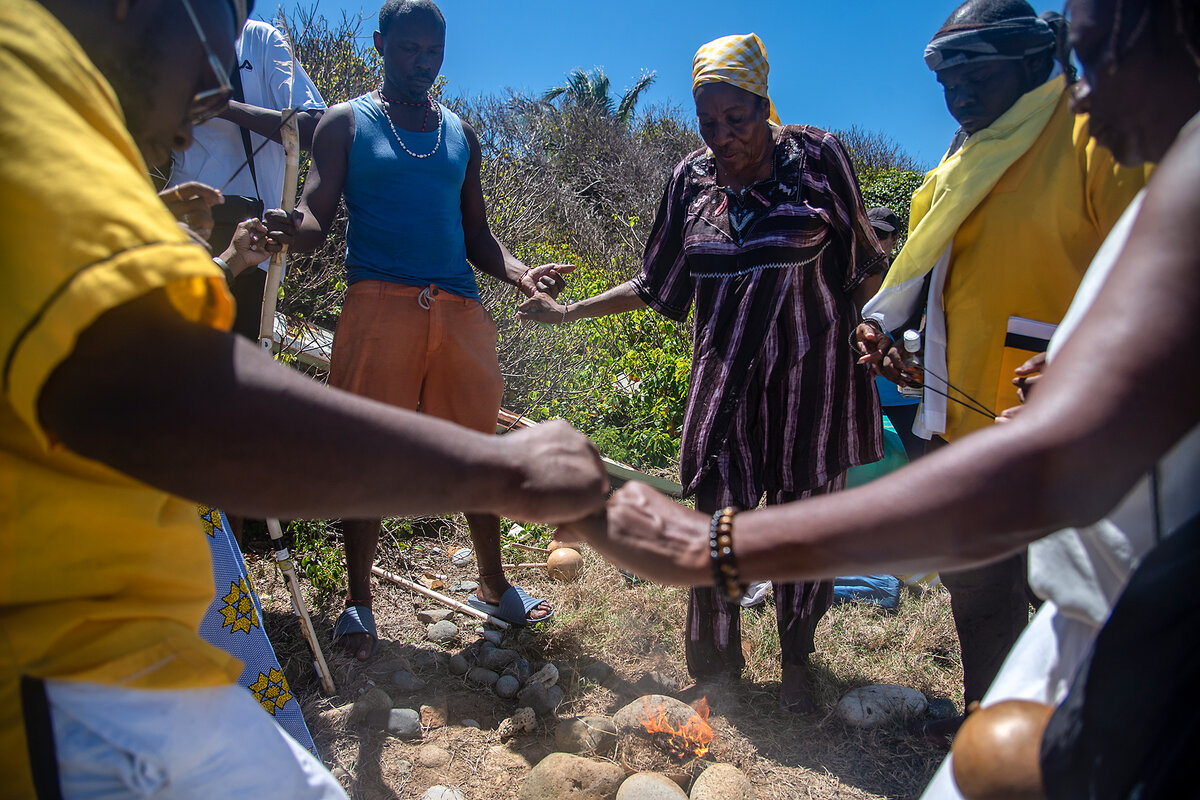
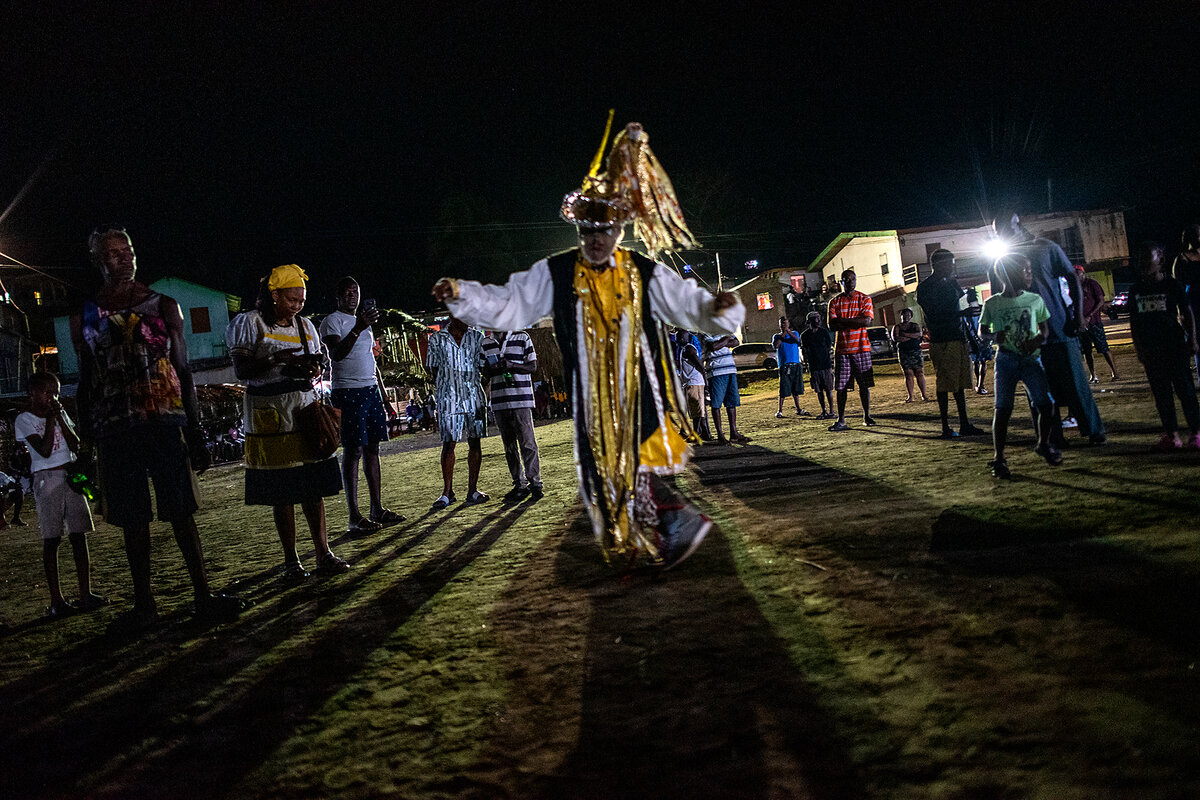
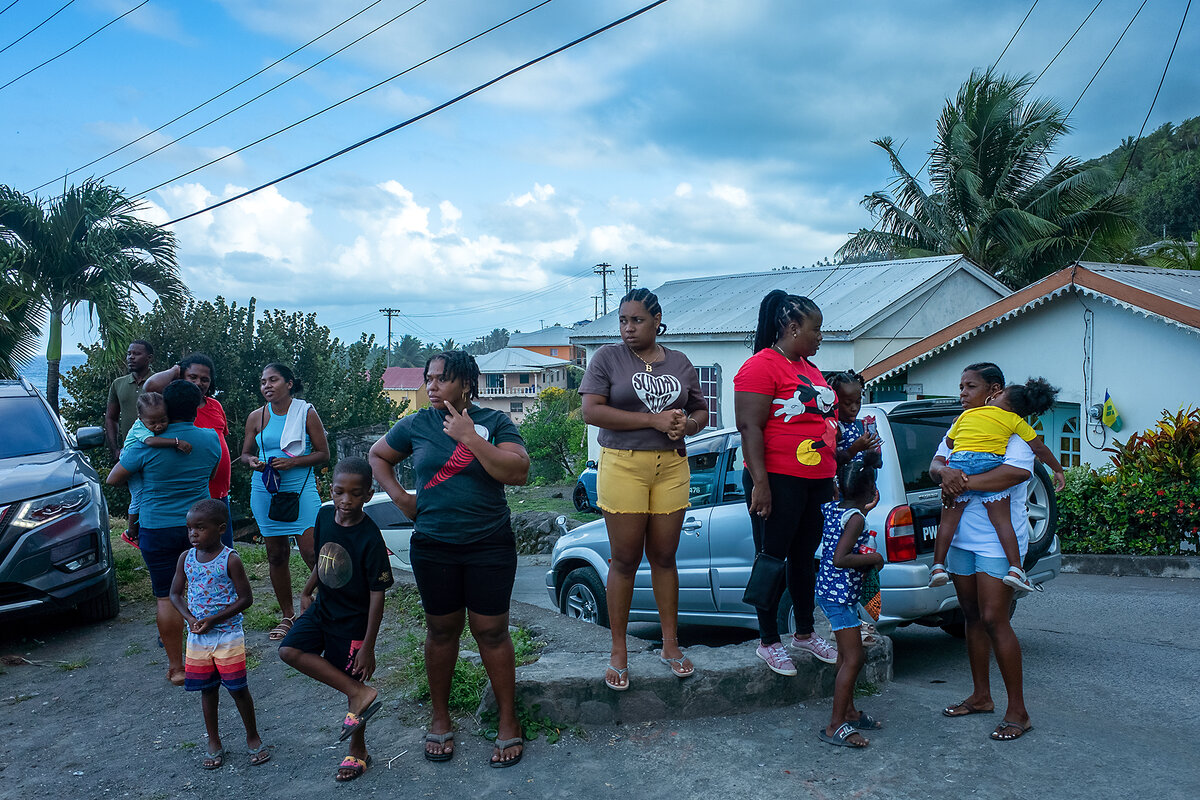
For more visual storytelling that captures communities, traditions, and cultures around the globe, visit The World in Pictures.
Other headline stories we’re watching
(Get live updates throughout the day.)The Monitor's View
Yankee Dodger Dandy
- Quick Read
- Deep Read ( 2 Min. )
-
By the Monitor's Editorial Board
During this autumn season, when the very idea of America is again being tested in an election, baseball’s balm is back.
For decades, pro ball helped carry the nation through wars and economic downturns and 9/11. It has felt increasingly forgotten lately – its measured pace out of sync with the swagger and sprint of a socially wired age. Yet past and present are poised to rhyme.
For the first time since the first year of the Reagan administration, the New York Yankees and the Los Angeles Dodgers are in the World Series. Back then, too, Americans worried about inflation, immigration, and war. And then, as now, they found solace in what the actor Kevin Costner has described as “the primal battle between a man with a stick and a man with a rock.”
Baseball’s appeal lies in its unhurried storytelling. A noble battle with inherent failure unfolds in a narrative in which all that happens on the diamond finds meaning in all the moments of joy and greatness that happened there before.
For a nation on the cusp of political change, this series offers a pause of shared delights in the gallantry and grace of a timeless sport.
Yankee Dodger Dandy

During this autumn season, when the very idea of America is again being tested in an election, baseball’s balm is back.
For decades, pro ball helped carry the nation through wars and economic downturns and 9/11. It has felt increasingly forgotten lately – its measured pace out of sync with the swagger and sprint of a socially wired age. Yet past and present are poised to rhyme.
For the first time since the first year of the Reagan administration, the New York Yankees and the Los Angeles Dodgers are in the World Series. Back then, too, Americans worried about inflation, immigration, and war. And then, as now, they found solace in what the actor Kevin Costner has described as “the primal battle between a man with a stick and a man with a rock.”
Baseball “has long been a cornerstone of national identity, transcending cultural and generational divides through its universal appeal,” wrote Patrick Gordon, executive editor of Philadelphia Baseball Review, last month. It is “a symbol of American perseverance ... of resilience and unity.”
This year’s teams have met in the World Series 11 times before, more than any other two. (For seven of those 11 series, the Dodgers were in Brooklyn, New York.) The players come from 29 states, and many emigrated from Japan, Cuba, Venezuela, Nicaragua, the Dominican Republic, and the Bahamas. They include some of the best athletes the game has ever seen, including Shohei Ohtani, the Dodger from Japan who in September became the only player to hit 50 home runs and steal 50 bases in a single season.
When these two historic rivals take the field, they won’t be foreigners or political activists. Just ballplayers on teams testing their mettle against each other.
Baseball’s appeal lies in its unhurried storytelling. A noble battle with inherent failure unfolds in a narrative in which all that happens on the diamond finds meaning in all the moments of joy and greatness that happened there before. “Watching baseball, sitting in the sun, eating popcorn, reading Ezra Pound,” wrote the poet Lawrence Ferlinghetti.
For a nation on the cusp of political change, this series offers a pause of shared delights in the gallantry and grace of a timeless sport.

A Christian Science Perspective
Each weekday, the Monitor includes one clearly labeled religious article offering spiritual insight on contemporary issues, including the news. The publication – in its various forms – is produced for anyone who cares about the progress of the human endeavor around the world and seeks news reported with compassion, intelligence, and an essentially constructive lens. For many, that caring has religious roots. For many, it does not. The Monitor has always embraced both audiences. The Monitor is owned by a church – The First Church of Christ, Scientist, in Boston – whose founder was concerned with both the state of the world and the quality of available news.
Embracing change: A spiritual approach
- Quick Read
- Read or Listen ( 3 Min. )
-
By Menganyi Moroga
As we come to know that God’s goodness is perpetual, we rejoice in our forward steps and experience blessings along the way.
Embracing change: A spiritual approach
Living in a world filled with constant change can feel unsettling. And some shifts – whether in our personal lives, the workplace, or the globe – are so big or sudden that it seems we can’t help but feel overwhelmed.
But I’ve learned through Christian Science that we don’t have to be afraid of change. Instead, we can trust in God’s unchanging goodness, which is always guiding and supporting us.
In “Science and Health with Key to the Scriptures,” Mary Baker Eddy, the founder of Christian Science, tells us, “The divine Mind that made man maintains His own image and likeness” (p. 151). This speaks to the permanence of God’s love and care for each of us, His image and likeness.
No matter how much the world around us changes, we can rest assured that God’s spiritual creation – what we all truly are – remains intact and undisturbed. God’s goodness is continually expressed in our lives and everywhere. This understanding allows us to face change without fear.
Jesus taught and demonstrated how to embrace change with grace and confidence, trusting that God is always in control. He fully expressed Christ, the true idea of God, which shows us the unbreakable link we have with divine Love.
When we look to Christ, we gain a clearer view of God’s perfect plan for us, including constant progress and growth. This Christly understanding enables us to see that every moment is an opportunity to witness more of God’s care and direction.
There was a time when I faced a significant career change, and at first I was filled with uncertainty. But as I prayed, it became clear to me that I could actively embrace this change as a spiritual opportunity.
I saw that what I really needed wasn’t to just find a new job or adapt to a new role, but to grow in my understanding of God’s infinite provision. Each step forward, inspired by prayer, revealed more of God’s plan for me, opening doors to new experiences, insights, and connections that I would not have encountered otherwise.
And instead of feeling anxious, I became excited about the new possibilities. This shift in perspective allowed me to see change not as something to fear, but as a chance to grow in faith and understanding.
The Bible assures us in Isaiah, “Behold, I will do a new thing; now it shall spring forth” (43:19). Every change, when seen through the lens of spiritual understanding, is a fresh opportunity for bearing witness to the spiritual fact of God’s goodness, which is constantly unfolding. Availing ourselves of such opportunities can help us more fully realize our purpose and potential as expressions of God’s love.
As we trust in God’s unchanging love, we can move through life’s transitions with grace, knowing that divine Love is always leading us to greater heights. Just as nature continually renews itself, we too can experience renewal through spiritual understanding. At every step we can feel God moving us toward deeper spiritual insights and a more profound sense of peace.
At a time when the world seems to be shifting beneath our feet, instead of resisting change, we can lean into it with confidence, knowing that Christ is bringing to light within us a greater understanding of ourselves and our unity with God. As we navigate the complexities of life, let us remember that we are not alone, but in the divine presence. God is always with us, providing the strength, wisdom, and joy we need to adapt and flourish.
Each change is an opportunity to grow spiritually, to learn more about God’s presence in our lives, and to experience the peace that comes from trusting in God’s perfect care.

Viewfinder
Desert bloom

A look ahead
Thank you for coming along with us today. We’ll start off next week with a look at how the vote count in the upcoming U.S. presidential election could be like 2020 – and how it could be different.


